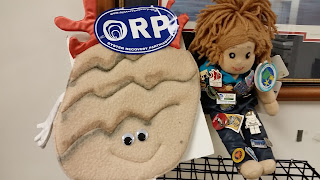You might think that they are ugly, have a horrible texture when in your mouth and they don't seem to do much...but you're wrong! Oysters are high in calcium, iron and protein and once you've got past the 'ickyness" of the flesh, they're quite tasty. Ask all the posh people, they love to eat oysters :)
I don't want to talk about eating my ocean buddies though, I want to tell you about the Oyster Recovery Partnership (ORP) who I visited recently. I got to have a look at what they are doing to help the Chesapeake Bay.
 |
| Me with Flat Shelly, the ORP mascot. |
There are true oysters (food oysters) and pearl oysters, but the food oysters can produce pearls too. Oyster shells are usually pear or oval in shape, but it depends on what they attach themselves to. I've seen a few that can't be described as any shape! They have a whitish-grey outside shell and on the inside they have a porcelain white inside shell. They've got strong muscles that close their shells when they are threatened and they feed by drawing water over their gills and eating the titbits floating around in the water.
Each adult oyster, on average, filters 189 litres (50 gallons) of water a day! Check out this video which shows you how these filter feeders clean up the water:
https://youtu.be/1Zm-yMpHsaQ
Not only do oyster reefs purify the water, but they also create ideal habitats (homes) for a number of other animals (crabs, fish etc). This is why ORP is getting people together to restore oyster reefs:
https://youtu.be/U8TNeusghYs
In order to restore the reefs though, they need shells for the spat (baby oysters) to grow on,
so ORP came up with shell recycling where restaurants get involved by collecting their used oyster shells for the reefs.
 |
| Collected oyster shells. |
 |
| A ship full of oyster shells about to wash them overboard to make another reef. |
What a great idea!
I ended my visit with ORP by taking a visit to the Horn Point Lab hatchery in Cambridge, MD - which is the world's largest oyster hatchery of the species called C. virginica. I couldn't believe it when I learnt that in the 2014 oyster planting season, over 800 million spat-on-shell was produced in the lab and planted back in the local waterways!
I ended my visit with ORP by taking a visit to the Horn Point Lab hatchery in Cambridge, MD - which is the world's largest oyster hatchery of the species called C. virginica. I couldn't believe it when I learnt that in the 2014 oyster planting season, over 800 million spat-on-shell was produced in the lab and planted back in the local waterways!
ORP work together with scientists to learn better ways to grow oysters and restore oyster reefs, they teach the public how they can help and they work with those people who make the laws so that oyster restoration is encouraged. I love it when people work together to help our animals!
If you'd like to find out more, go to: http://www.oysterrecovery.org/
Thanks to Bryan Gomes for having me.
Have a great week Sea Fans!
Have a great week Sea Fans!
Chat soon.
Cheers.
Abby
}( *)8










